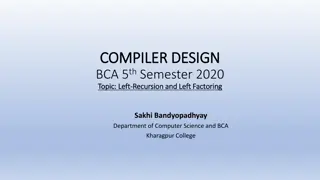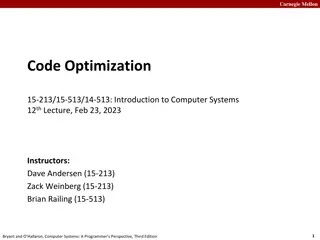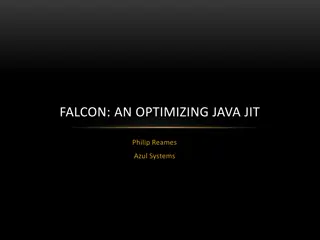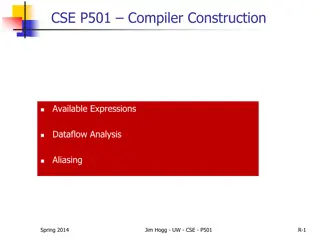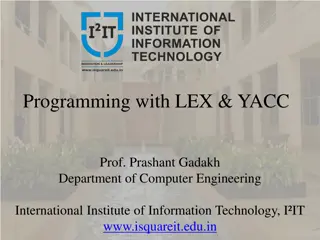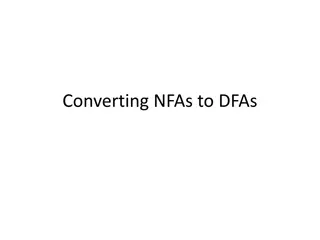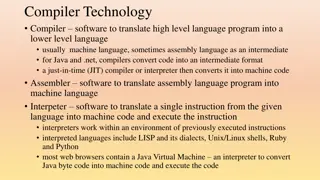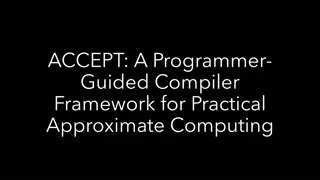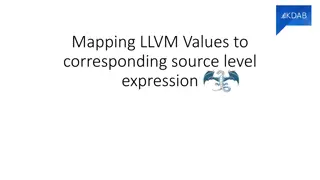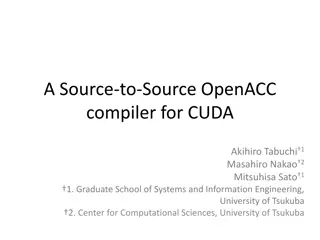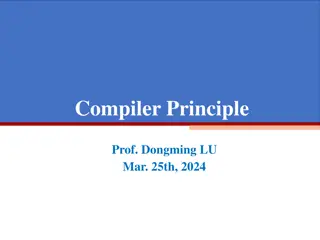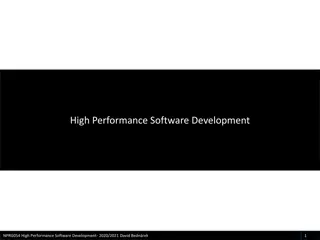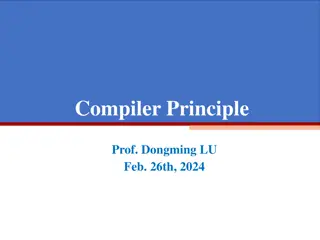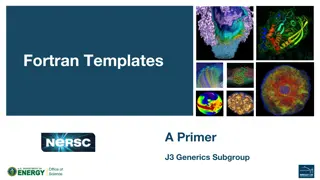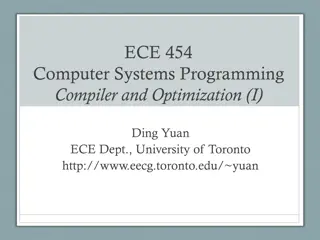Introduction to Compiler: Process and Data Structures
Intricate process of compiling, from translating source code to generating target code. Learn about essential data structures like symbol tables and parse trees that play a crucial role in the compilation process.
Download Presentation

Please find below an Image/Link to download the presentation.
The content on the website is provided AS IS for your information and personal use only. It may not be sold, licensed, or shared on other websites without obtaining consent from the author.If you encounter any issues during the download, it is possible that the publisher has removed the file from their server.
You are allowed to download the files provided on this website for personal or commercial use, subject to the condition that they are used lawfully. All files are the property of their respective owners.
The content on the website is provided AS IS for your information and personal use only. It may not be sold, licensed, or shared on other websites without obtaining consent from the author.
E N D
Presentation Transcript
Introduction Jaruloj Chongstitvatana Department of Mathematics and Computer Science Chulalongkorn University Chapter 1 2301373: Introduction 1
What is a Compiler? A compiler is a computer program that translates a program in a source language into an equivalent program in a target language. A source program/code is a program/code written in the source language, which is usually a high-level language. Source program Target program compiler A target program/code is a program/code written in the target language, which often is a machine language or an intermediate code. Error message Chapter 1 2301373: Introduction 2
Process of Compiling Stream of characters scanner Stream of tokens parser Parse/syntax tree Semantic analyzer Annotated tree Intermediate code generator Intermediate code Code optimization Intermediate code Code generator Target code Code optimization Target code Chapter 1 2301373: Introduction 3
Some Data Structures Symbol table Literal table Parse tree Chapter 1 2301373: Introduction 4
Symbol Table Identifiers are names of variables, constants, functions, data types, etc. Store information associated with identifiers Information associated with different types of identifiers can be different Information associated with variables are name, type, address,size (for array), etc. Information associated with functions are name,type of return value, parameters, address, etc. Chapter 1 2301373: Introduction 5
Symbol Table (contd) Accessed in every phase of compilers The scanner, parser, and semantic analyzer put names of identifiers in symbol table. The semantic analyzer stores more information (e.g. data types) in the table. The intermediate code generator, code optimizer and code generator use information in symbol table to generate appropriate code. Mostly use hash table for efficiency. Chapter 1 2301373: Introduction 6
Literal table Store constants and strings used in program reduce the memory size by reusing constants and strings Can be combined with symbol table Chapter 1 2301373: Introduction 7
Parse tree Dynamically-allocated, pointer-based structure Information for different data types related to parse trees need to be stored somewhere. Nodes are variant records, storing information for different types of data Nodes store pointers to information stored in other data structure, e.g. symbol table Chapter 1 2301373: Introduction 8
Scanning A scanner reads a stream of characters and puts them together into some meaningful (with respect to the source language) units called tokens. It produces a stream of tokens for the next phase of compiler. Chapter 1 2301373: Introduction 9
Parsing A parser gets a stream of tokens from the scanner, and determines if the syntax (structure) of the program is correct according to the (context-free) grammar of the source language. Then, it produces a data structure, called a parse tree or an abstract syntax tree, which describes the syntactic structure of the program. Chapter 1 2301373: Introduction 10
Semantic analysis It gets the parse tree from the parser together with information about some syntactic elements It determines if the semantics or meaning of the program is correct. This part deals with static semantic. semantic of programs that can be checked by reading off from the program only. syntax of the language which cannot be described in context-free grammar. Mostly, a semantic analyzer does type checking. It modifies the parse tree in order to get that (static) semantically correct code. Chapter 1 2301373: Introduction 11
Intermediate code generation An intermediate code generator takes a parse tree from the semantic analyzer generates a program in the intermediate language. In some compilers, a source program is translated into an intermediate code first and then the intermediate code is translated into the target language. In other compilers, a source program is translated directly into the target language. Chapter 1 2301373: Introduction 12
Intermediate code generation (contd) Using intermediate code is beneficial when compilers which translates a single source language to many target languages are required. The front-end of a compiler scanner to intermediate code generator can be used for every compilers. Different back-ends code optimizer and code generator is required for each target language. One of the popular intermediate code is three-address code. A three-address code instruction is in the form of x = y op z. Chapter 1 2301373: Introduction 13
Code optimization Replacing an inefficient sequence of instructions with a better sequence of instructions. Sometimes called code improvement. Code optimization can be done: after semantic analyzing performed on a parse tree after intermediate code generation performed on a intermediate code after code generation performed on a target code Chapter 1 2301373: Introduction 14
Code generation A code generator takes either an intermediate code or a parse tree produces a target program. Chapter 1 2301373: Introduction 15
Error Handling Error can be found in every phase of compilation. Errors found during compilation are called static (or compile-time) errors. Errors found during execution are called dynamic (or run-time) errors Compilers need to detect, report, and recover from error found in source programs Error handlers are different in different phases of compiler. Chapter 1 2301373: Introduction 16
Reading Assignment Louden, K.C., Compiler Construction: Principles and Practice, PWS Publishing, 1997. ->Chapter 1 Chapter 1 2301373: Introduction 17


